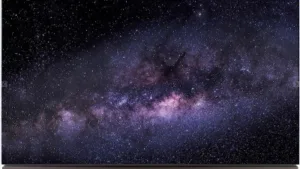I am writing this on the day after July Fourth, a holiday on which we in the U.S.A. celebrate our liberation from tyrants, eat hot dogs and hamburgers, and drink beer that Display Daily’s British publisher Bob Raikes says reminds him of a yellowish bodily effluent*.

I will put that image aside and focus on the fact that a very pleasant early summer has finally arrived here in southwestern New England. In other words, I would rather be sitting in the Adirondack chair on the patio than tapping on a keyboard.
But since I do have to tap, and since digging through the technological weeds — to try and explain the characteristics and significance of, say, Oledon’s planar-source fine metal mask (FMM) vacuum thermal evaporator for OLED displays, which produces greater pixel density than previous VTE techniques — is completely beyond my abilities at the moment, I have only one option. And that is to rise to 30,000 feet for a big-picture view that requires absolutely no new research.
In fact, there is a group of interrelated issues I’ve been writing about recently, but perhaps not from a sufficiently high big-picture altitude. Come to think of it, let’s put away the Nikon and take out the camera-phone. Instead of a big picture, we’ll take a snapshot instead.
Snapshot: There is considerable growth in store for OLED displays in smart phones, other battery-operated devices, and automotive applications. But the growth in TVs may be considerably less than many analysts were predicting just two or three ago.
Brief explanation: It was generally agreed a couple of years ago that OLED was the best premium TV technology, and all LG Display (LGD) had to do was increase manufacturing yield and reduce cost. It was further agreed that some kind of solution processing (like ink-jet printing) would solve these problems and that it wasn’t far away. Unfortunately, the challenges of solution processing have remained, well, challenging, and help from that quarter is coming slowly.
Meanwhile, premium LCD technology has advanced rapidly. Black levels of super-premium quantum-dote-enhanced sets are a just-noticeable-difference away from the very high standard set by OLED, and the peak white luminance of the best sets is between 2000 and 2500 nits, two-and-a-half to three times that of the best OLEDs. The result is a greater color volume for the QD-enhanced LCD sets — and a price that is, at the moment, not far away from the OLED competition.
As a result, OLED-TV market penetration is projected to rise from 1% this year to perhaps 6% in 2021, and some analysts feel that’s optimistic. If you’re inclined to think that multiplying your market penetration by a factor of six in four years is wonderful, you can spin an optimistic story about OLED-TV’s future. But if you fear that 6% is for OLED-TV what Gettysburg was for Robert E. Lee — the high water mark — then you can spin a pessimistic story. If the OLED-TV story is to be optimistic for the long term, LGD has to reduce cost, increase peak white luminance, and improve lifetime, and do all of it fairly quickly.
I will be speaking with LGD executives in Seoul and Paju next week. Maybe I’ll learn something. – Ken Werner
* I deny this. While, thirty years ago, there was very little choice in American beers and with most, I would have welcomed something with as much flavour as a body fluid, these days I find myself regularly explaining to those that have old stereotypes of the US or haven’t visited for a long time, that micro-breweries are tremendous in the US and there is, arguably more choice in beers in the US now than in most of Europe. (BR)
Ken Werner is Principal of Nutmeg Consultants, specializing in the display industry, manufacturing, technology, and applications, including mobile devices and television. He consults for attorneys, investment analysts, and companies re-positioning themselves within the display industry or using displays in their products. He is the 2017 recipient of the Society for Information Display’s Lewis and Beatrice Winner Award. You can reach him at [email protected].

